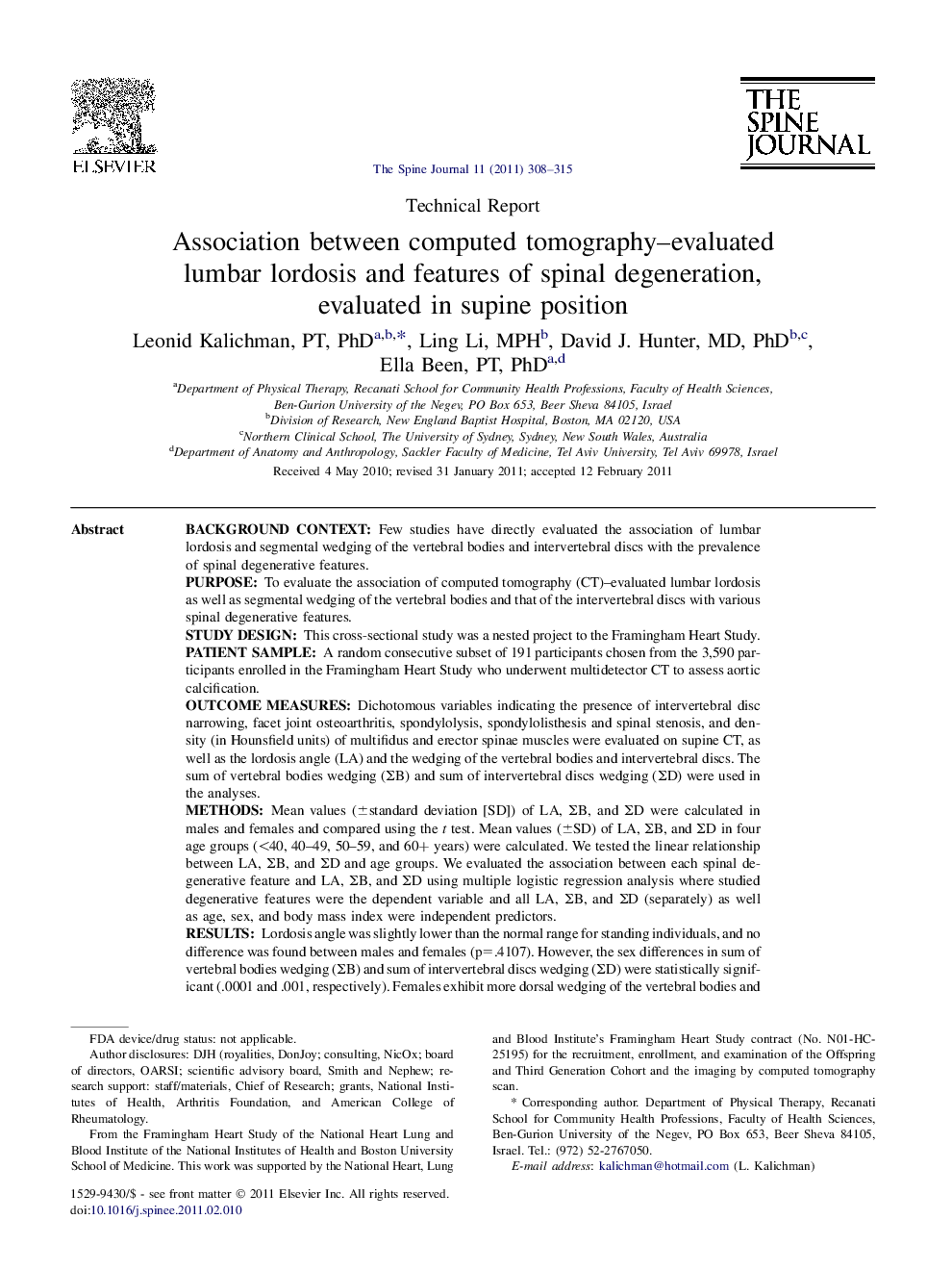| کد مقاله | کد نشریه | سال انتشار | مقاله انگلیسی | نسخه تمام متن |
|---|---|---|---|---|
| 6212822 | 1268601 | 2011 | 8 صفحه PDF | دانلود رایگان |

Background contextFew studies have directly evaluated the association of lumbar lordosis and segmental wedging of the vertebral bodies and intervertebral discs with the prevalence of spinal degenerative features.PurposeTo evaluate the association of computed tomography (CT)-evaluated lumbar lordosis as well as segmental wedging of the vertebral bodies and that of the intervertebral discs with various spinal degenerative features.Study designThis cross-sectional study was a nested project to the Framingham Heart Study.Patient SampleA random consecutive subset of 191 participants chosen from the 3,590 participants enrolled in the Framingham Heart Study who underwent multidetector CT to assess aortic calcification.Outcome measuresDichotomous variables indicating the presence of intervertebral disc narrowing, facet joint osteoarthritis, spondylolysis, spondylolisthesis and spinal stenosis, and density (in Hounsfield units) of multifidus and erector spinae muscles were evaluated on supine CT, as well as the lordosis angle (LA) and the wedging of the vertebral bodies and intervertebral discs. The sum of vertebral bodies wedging (ΣB) and sum of intervertebral discs wedging (ΣD) were used in the analyses.MethodsMean values (±standard deviation [SD]) of LA, ΣB, and ΣD were calculated in males and females and compared using the t test. Mean values (±SD) of LA, ΣB, and ΣD in four age groups (<40, 40-49, 50-59, and 60+ years) were calculated. We tested the linear relationship between LA, ΣB, and ΣD and age groups. We evaluated the association between each spinal degenerative feature and LA, ΣB, and ΣD using multiple logistic regression analysis where studied degenerative features were the dependent variable and all LA, ΣB, and ΣD (separately) as well as age, sex, and body mass index were independent predictors.ResultsLordosis angle was slightly lower than the normal range for standing individuals, and no difference was found between males and females (p=.4107). However, the sex differences in sum of vertebral bodies wedging (ΣB) and sum of intervertebral discs wedging (ΣD) were statistically significant (.0001 and .001, respectively). Females exhibit more dorsal wedging of the vertebral bodies and less dorsal wedging of the intervertebral discs than do males. All these parameters showed no association (p>.05) with increasing age. Lordosis angle showed statistically significant association with the presence of spondylolysis (odds ratio [95% confidence interval]: 1.08 [1.02-1.14]) and with the density of multifidus (1.06 [1.01-1.11]) as well as a marginally significant association with isthmic spondylolisthesis (1.07 [1.00-1.14]). ΣB showed a positive association with degenerative spondylolisthesis and disc narrowing (1.14 [1.06-1.23] and 1.04 [1.00-1.08], correspondingly), whereas ΣD showed a negative one (0.93 [0.87-0.98] and 0.93 [0.89-0.97], correspondingly).ConclusionsSignificant associations were found between lumbar lordosis evaluated in supine position and segmental wedging of the vertebral bodies and intervertebral discs and the prevalence of spondylolysis and spondylolisthesis. Additional studies are needed to evaluate the association between spondylolysis, isthmic and degenerative spondylolisthesis and vertebral and disc wedging at the segmental level.
Journal: The Spine Journal - Volume 11, Issue 4, April 2011, Pages 308-315